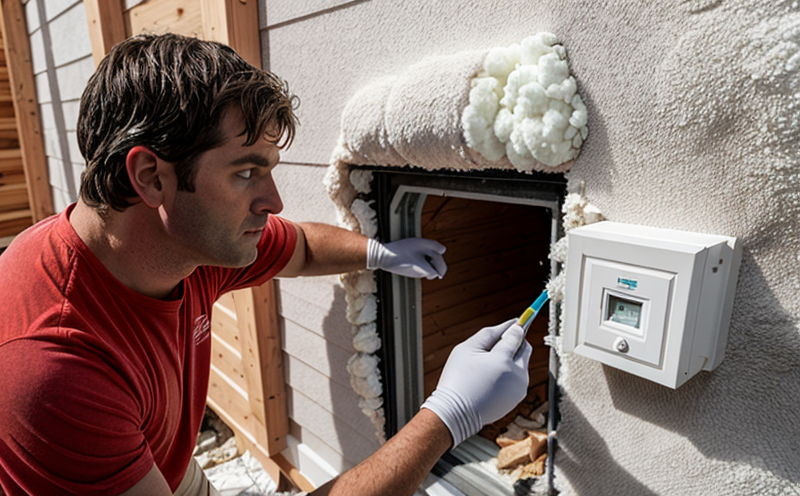EN 1604 Compressive Behavior and Thermal Conductivity
The European Standard EN 1604 defines the methods for determining the compressive behavior of thermal insulation products, along with their thermal conductivity. This service is critical in ensuring that building materials meet stringent performance criteria, especially in the context of energy efficiency and sustainability.
EN 1604 plays a pivotal role in quality assurance by providing standardized procedures to measure how well insulation products can withstand compressive forces without compromising on their thermal properties. This standard ensures that insulations are robust enough for real-world applications while maintaining effective thermal performance.
The testing process involves subjecting samples of the insulation material to controlled compression until failure occurs, measuring both the force required and the resulting deformation. Simultaneously, thermal conductivity is measured using a guarded hot plate apparatus, which allows for accurate determination under defined conditions.
This service is essential for manufacturers aiming to comply with international regulations and improve product performance. It enables them to optimize their materials, ensuring they meet or exceed expected standards in terms of both structural integrity and thermal efficiency.
By leveraging EN 1604, stakeholders can gain confidence that the insulations used will perform reliably across various climates and conditions, contributing significantly to overall building sustainability efforts.
Why It Matters
The importance of EN 1604 cannot be overstated when it comes to the design and construction of energy-efficient buildings. Insulation materials are crucial components in achieving these goals, as they play a key role in minimizing heat transfer between interior and exterior environments.
Testing according to this standard helps verify that insulation products can withstand typical pressures encountered during installation without compromising their thermal performance. This durability ensures long-term effectiveness, which is vital for reducing heating and cooling costs over the lifetime of a building.
Additionally, accurate measurement of thermal conductivity provides valuable data on how efficiently heat is being managed within the structure. Lower values indicate better insulating properties, leading to improved occupant comfort and reduced environmental impact.
For quality managers and compliance officers, adhering to EN 1604 ensures that products meet necessary specifications set forth by relevant authorities. This not only protects against potential legal issues but also enhances brand reputation through proven performance reliability.
R&D engineers benefit from this service as well since it allows them to refine formulas and manufacturing processes continuously based on empirical evidence gathered during testing. Such insights contribute significantly towards developing next-generation solutions that push boundaries further in terms of innovation and efficiency.
In summary, EN 1604 provides a robust framework for assessing the compressive behavior and thermal conductivity of insulation materials, ultimately supporting sustainable practices within the building industry.
Environmental and Sustainability Contributions
The implementation of EN 1604 aligns closely with broader environmental initiatives aimed at fostering sustainability across all sectors, including construction. By promoting the use of high-quality insulation products, this standard contributes positively to several UN Sustainable Development Goals (SDGs), particularly SDG 7 on affordable and clean energy, and SDG 13 on climate action.
Optimizing thermal performance through rigorous testing according to EN 1604 helps reduce greenhouse gas emissions by enhancing building efficiency. This leads to lower energy consumption levels, thereby decreasing reliance on fossil fuels for heating and cooling purposes. Consequently, there is less demand placed on power plants, which in turn reduces carbon dioxide emissions associated with electricity generation.
Moreover, the use of efficient insulation systems supported by EN 1604 supports circular economy principles by extending product lifecycles and reducing waste. It encourages manufacturers to produce durable goods that can continue performing optimally over extended periods without frequent replacements, thus minimizing resource depletion.
Incorporating sustainable practices like those outlined in EN 1604 also promotes healthier indoor environments for occupants. Better thermal regulation translates into more comfortable living spaces where people feel less strain from extreme temperatures, leading to improved quality of life and productivity.
Overall, adhering to EN 1604 fosters a culture of responsible resource management within the construction industry while contributing significantly towards global efforts aimed at combating climate change and promoting sustainable development.
Use Cases and Application Examples
| Application Example | Description |
|---|---|
| Residential Housing Insulation | Testing insulating materials for new residential projects ensures they meet required thermal resistance levels, contributing to energy savings and improved living conditions. |
| Commercial Building Upgrades | Evaluating existing insulation in commercial buildings helps identify areas needing improvement, allowing for targeted interventions that enhance overall building performance. |
| Renewable Energy Facilities | Ensuring proper thermal insulation around renewable energy systems such as solar panels improves efficiency and longevity of these installations. |
| Industrial Plants | Testing insulating materials used in industrial settings ensures they maintain optimal temperatures, supporting efficient operation without excessive heat loss or gain. |
| Hospitals and Healthcare Facilities | Optimizing insulation in healthcare facilities contributes to quieter environments by reducing noise transfer between rooms and floors. |
| Public Transportation Infrastructure | Evaluating insulating materials for public transport infrastructure enhances passenger comfort while minimizing operational costs related to heating or cooling. |
| Sporting Venues | Ensuring proper insulation in sports venues helps maintain consistent indoor climate conditions, ensuring optimal performance during events. |
| Logistical Warehouses and Cold Storage Facilities | Evaluating insulating materials used in cold storage facilities ensures minimal heat gain, preserving product quality throughout the supply chain. |
The above examples illustrate just a few of the many scenarios where EN 1604 testing is applicable. Each application serves to enhance performance and reliability, ultimately contributing towards achieving sustainable goals in various sectors.





